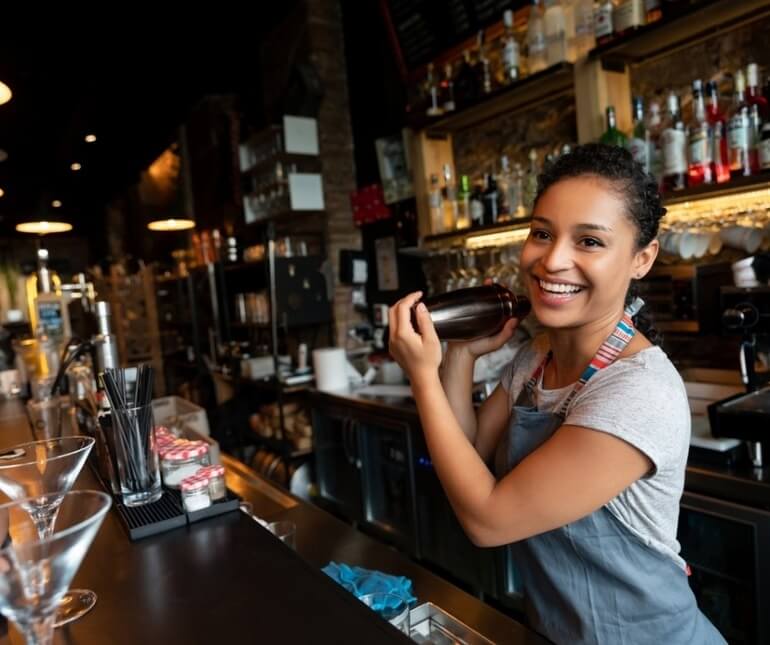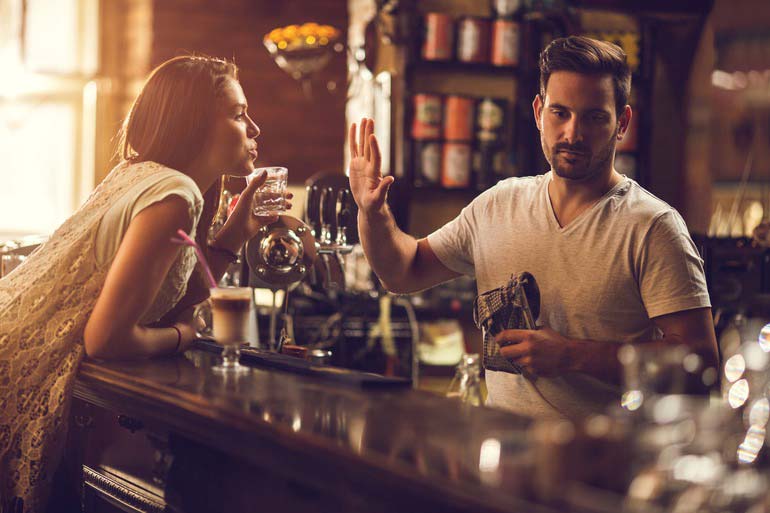Bartending 101 means knowing the basics of small talk just as much as it means knowing how to mix a great drink. So if you’re a bartender who knows how to make a mean cocktail but can’t seem to come out of your shell for the other part of your job, you’ve come to the right place.
Here are some bartender do’s and don’ts for a great conversation between you and your customers.
Do master the art of small talk – with icebreakers.
Some people are just naturally great at creating conversation – and others need to have some icebreakers in their back pocket. Here are some great icebreakers to spark up a conversation with your customers:
- What are your exciting plans for the night?
- Are you from the neighborhood?
- Is this your first time here? or I see you around a lot, you must like the place!
- Introduce yourself, ask them their name.
- Where are you coming from?
- Give them a compliment, which doesn’t have to be about their appearance – “You look like you’re having fun!”

Use this checklist to help streamline the training process for new bar staff and set them up for success.
Don’t engage in discussions about politics or religion.
Keep it light! You never know who’s sitting on the other side of your bar, so avoid sensitive subjects altogether for a frictionless customer experience. We’re living in a polarizing time, and odds are your customers are out for a night of escape, not to defend their beliefs or have to deal with yours. Sometimes controversial topics can arise naturally. If they do, it might be best to pivot the conversation to another topic, or just disengage for a while.
Do Develop a relationship with regulars.
Having return customers is crucial for sustained success in the bar industry. When a regular walks in, don’t be afraid to give them a warm welcome and treat them with a heightened amount of admiration. Remembering worthwhile information that you learned about them during previous visits is a great way to strengthen a bond. Remember the order they made last time and ask them if they’d like the usual – it’s a great way to earn brownie points.
Do keep up with current events.

While you want to avoid politics, that doesn’t mean you won’t want to talk about current events. People love to learn new information, and you could be the one to transmit a great little nugget of knowledge that your customer can use to impress their friends. Whether you talk about the game from the night before or an upcoming holiday, timely topics make for effortless and interesting conversation. Subjective debates on topics like the hot movie in theaters or local musical artists are always good icebreakers for worthwhile conversations.
Don’t be aggressive in your attempts to converse.
There are extroverts, and then there are introverts. While some guests are happy to chat with their bartender while they’re sitting at the bar, others want some silence with their alcohol. You’ll need to “read the room” when you’re striking up conversation with your customers, so you can sense whether or not they’re responding to your attempts at chit chat. If they’re not, serve them a drink with a smile and move on. Remember most groups go to bars to have fun with their friends, not to make friends with the staff. Becoming friends is a bonus – but it’s not necessary.
Do know the lingo.
If you’re going to walk the walk, you better talk the talk. There’s a full dictionary worth of terms and slang that go along with being an expert mixologist. In case you ever come across a liquor connoisseur, make sure you’re up to date on the lingo.
Here’s some basic terms that are need to know:
- Dirty – when a drink is served with juice from bar olives mixed in.
- Dry – when a drink is served mixed with vermouth. (Usually associated with gin or vodka martinis)
- Mixer – non-alcoholic substances added to drinks.
- Neat – served not chilled prior or over ice. Straight from the bottle to the glass.
- On the rocks – served with ice.
- Virgin – served with all mixer, no alcohol included.

Use this checklist to help streamline the training process for new bar staff and set them up for success.
Don’t forget to greet guests when you’re busy.
It can be very frustrating when you arrive at a busy bar and feel like the bartender has no idea you’re waiting to be served. No matter how busy it is, it’s important to always acknowledge when a new customer has arrived.
Even if it will take some time to serve the new arrivals, take a moment to greet them and tell them you’ll be with them ASAP. Taking a second to say welcome, or even a quick smile, prevents the guest from feeling neglected and prepares them to be patient.

Do be kind and compassionate.
As the saying goes, “Be kind, for everyone you meet is fighting a battle you know nothing about.” The same holds true for your guests. For some, you may take on the role of the therapist; for others, your company alone is enough. When a customer feels like they have a friend in a bartender, they’re more likely to become a repeat customer and leave hefty tips. You can even help keep guests safe by learning safety lingo like the angel shot.
Don’t be impatient.
There’s nothing worse than asking a customer, “What can I get you?” before they’ve had the chance to settle in or read a menu. Don’t fret – they will place an order. To start just ask them how they’re doing, then occupy yourself with a light task to keep you from hovering while they make a decision.
Do suggest snacks and food.
Eating and drinking, a match made in heaven. Offering snacks and food at the bar is a great way to prevent guests from leaving to go get a meal somewhere else. The longer a customer stays at the bar, the more they spend.
Knowing your food menu and being able to suggest food/drink pairings is a great way to sell more of both.
Do know the difference between attentive and smothering.
You can safely assume your guests want to sit back, relax, and enjoy a great drink. What they don’t want is to try to get your attention or receive too much attention from a chatty waiter. Know the difference between these two extremes and deliver accordingly.
Your guests are paying for booze, but they’re tipping for service. Ensure yours is top notch by keeping these bartending basics top of mind during your shift. Mastering the art of small talk will benefit you behind the bar and beyond – and we’ll cheers to that!
Do make recommendations.
Never be afraid to use you expertise to make a recommendation. If a customer is indecisive between a couple of options on the menu, you can tell them which you prefer.
If you can take one decision out of a busy person’s day, they may thank you for it. Just make sure the recommendation is a two-way dialogue to get a picture of what they like, so you can effectively make a suggestion. Who knows, you might even introduce someone to their new favorite cocktail or different mocktails to order at a restaurant.
Also make sure to handle any complaints or disagreements graciously. Let’s say you serve a customer the best Cosmopolitan they’ve ever had, and they ask for a recommendation. You offer them an Aperol Spritz and it doesn’t go over well. Don’t hesitate to try and mend the relationship – try to replace the drink with something closer to what they like.
Check out our list of well drinks and why they’re an important part of your bar program.

Don’t be afraid to cut someone off.
One of your most important responsibilities as a bartender is to ensure that the environment is safe and enjoyable for everyone. If a customer is overserved it can ruin the experience for other guests and could potentially lead to a customer putting themselves or others in danger.
Common indicators of someone who has over-indulged include:
- Slurred speech
- General loss of balance
- Bloodshot or glazed over eyes
- Placing large orders (more than they need) in succession
- Inappropriate behavior
- Falling asleep
While it can be an awkward interaction to cut someone off, there are ways to approach it professionally, which help you protect yourself and your place of work.

Here are some of the best non-confrontational techniques for cutting off a customer:
- Settle the tab first.
- Be firm with refusing to pour another beverage. Speak in a calm, cool, and collected way, and be clear that you’re definitely not going to give them more alcohol.
- Don’t bargain with the patron. “Just one more and then I’ll leave”, isn’t going to be effective. When you cut them off, that has to be it. Stick to your word.
- Be respectful and don’t embarrass them. Keep it on the downlow as much as possible, and ensure them that they are welcome to come back another day, but tonight they’ve had enough.
- Make sure they are not driving. If they are with a group, check that someone is the designated driver, or they are all taking a cab together.
- Stay safe. Safety is priority – the safety of your other guests, the staff, and the individual.
- Ask them to leave the premises. Once they are cut off, there should be no sticking around or hanging out with friends that are ordering more alcohol and possibly sharing it with them.
- Help them safely on their way. This may mean calling a taxi or ordering an Uber and ensuring they are in the car and headed home, or making sure that friends or family with the patron are in control and taking care of them.
For more on this subject make sure to check out our best tips and techniques for responsible serving.

Use this checklist to help streamline the training process for new bar staff and set them up for success.
Do develop a knowledge of international trends.
Tending a bar can be a very different experience from country to country. If you deal with a customer from another country (or choose to work abroad), it can be helpful to know some of these trends so you can respond accordingly.
Certain countries have different cocktails, or entirely different names for common local cocktails. For example, a Bloody Caesar is a very common cocktail in Canada but seldom found elsewhere in the world. Similar to the Blood Mary, a Caesar contains both tomato and clam juice, a mixture not commonly available in U.S. restaurants. If you have a guest who orders a Caesar and you don’t stock the right ingredients, offer them olives as a garnish to substitute for the salty flavor from the clam juice.
Did you know that in Scotland they spell whisky without the “e”? Not just that, but Scottish whisky is distilled in differently, with malted barley, while American bourbon is distilled from corn, and Canadian rye whiskey is distilled from multiple grains including rye.
In North America, Japanese rice wine is commonly referred to as Sake. But in Japan it is known as Nihonshu, while the term Sake actually refers to any alcoholic beverage.
Around the world, a common term for fruit-flavored spirits is “schnapps.” But in Germany and Austria, schnapps (direct translation: swallow) can be used to refer to any form of hard liquor.
People from the U.K. often pronounce certain wines with differently than other English-speaking countries. For example some Brits pronounce merlot with a hard “t,” and shiraz with a hard “s.” So if someone from the U.K. uses these pronunications, try not to laugh; they’re just using the pronunciation more commonly used in their neck of the woods.
Be aware of stereotypes and prejudices about international drinking cultures. For example, pop culture has introduced a stereotype that Australians commonly drink Fosters, an Australian beer brand famous for its oversized cans. But in actuality Foster’s isn’t commonly found in Australia and is actually brewed in the U.K. So don’t feed into any stereotypes by offering foreign customers seemingly typical drinks.
Another difference in bartending culture around the globe, is the amount of attention given to the customer. In the U.K., barkeeps do not typically give as much attention to a customer as you might find from a North American bartender. Therefore it might be a little off putting for a guest from the U.K. to be hovered over when having their drink.
Expanding your knowledge to include global reach can help foreign customers feel at home and will earn you extra admiration for knowing about their local customs. Don’t hesitate to do some research on how your job is done in other countries.
Now that you know how to be a good bartender…
Download your free employee handbook template
Sign up for our free weekly TouchBistro Newsletter







